http://kitup.military.com/2010/06/socom-cancels-mk-16-scar.html#ixzz0rtef9uMB

In an exclusive report for Military.com we reveal that US Spec Ops Command has abandoned the 5.56 version of the SCAR and will use FY 2011 money to buy more 7.62 Mk-17s to fill a “capability gap” for a 7.62 battle rifle.
Here’s an excerpt:
In a surprising reversal that follows years of effort to design a one-of-a-kind commando rifle, the U.S. military’s Special Operations Command has abruptly decided to abandon the new SOCOM Combat Assault rifle – the “SCAR,” as the rifle is commonly known – in favor of previously-fielded carbines.
Details provided exclusively to Military.com reveal that SOCOM, the Tampa-based command that oversees the training and equipping of SEALs, Green Berets, Air Force Special Tactics Teams and Marine SOC groups, will stop purchasing the 5.56 mm Mk-16 Special Operations Forces Combat Assault Rifle and might require all units who now have them to turn the new weapons back into the armory.
“The Mk-16 does not provide enough of a performance advantage over the M-4 to justify spending USSOCOM’s limited … funds when competing priorities are taken into consideration,” officials at USSOCOM said in an email response to questions from Military.com. “Currently, three of USSOCOM’s four components receive the 5.56 mm M-4 from their parent service as a service common equipment item.”
A couple things to note here, so far SOCOM has purchased 850 Mk-16s and 750 Mk-17s — way below their original requirement. The weird thing to consider here is that the requirement was for a 5.56 and that was what was competed. Now they’re buying a 7.62 that has no written requirement document attached to it.
Further, the SEALs are going to be particularly in the hurt locker on this one since the Navy doesn’t buy their guns, SOCOM does. I hear that it was Naval Special Warfare that really pushed this program and that it was the USASOC that basically killed it. More of the Mk-16s were fielded to SEALs than any other unit within SOCOM.
Also of note: I hear that the services who have them will have to hand back their Mk-16s when they’re back from deployment and pick up their old SOPMOD M4s or HK-416s. So so a final goodbye to your SCAR-16 when you’re back from The Box.
Two well-informed industry analysts tell me that SCAR-maker FNH-USA will try to sell SOCOM on the idea of a Mk-17 common receiver that can be turned into a 5.56 or other caliber by switching out part of the lower receiver. So FNH-USA is positioning itself to rescue the Mk-16 through the Mk-17. But there’s no indication that SOCOM is biting.
There will certainly be more on this story as it develops, but I wanted Kit Up! readers to be the first to know.
Have a great weekend!

In an exclusive report for Military.com we reveal that US Spec Ops Command has abandoned the 5.56 version of the SCAR and will use FY 2011 money to buy more 7.62 Mk-17s to fill a “capability gap” for a 7.62 battle rifle.
Here’s an excerpt:
In a surprising reversal that follows years of effort to design a one-of-a-kind commando rifle, the U.S. military’s Special Operations Command has abruptly decided to abandon the new SOCOM Combat Assault rifle – the “SCAR,” as the rifle is commonly known – in favor of previously-fielded carbines.
Details provided exclusively to Military.com reveal that SOCOM, the Tampa-based command that oversees the training and equipping of SEALs, Green Berets, Air Force Special Tactics Teams and Marine SOC groups, will stop purchasing the 5.56 mm Mk-16 Special Operations Forces Combat Assault Rifle and might require all units who now have them to turn the new weapons back into the armory.
“The Mk-16 does not provide enough of a performance advantage over the M-4 to justify spending USSOCOM’s limited … funds when competing priorities are taken into consideration,” officials at USSOCOM said in an email response to questions from Military.com. “Currently, three of USSOCOM’s four components receive the 5.56 mm M-4 from their parent service as a service common equipment item.”
A couple things to note here, so far SOCOM has purchased 850 Mk-16s and 750 Mk-17s — way below their original requirement. The weird thing to consider here is that the requirement was for a 5.56 and that was what was competed. Now they’re buying a 7.62 that has no written requirement document attached to it.
Further, the SEALs are going to be particularly in the hurt locker on this one since the Navy doesn’t buy their guns, SOCOM does. I hear that it was Naval Special Warfare that really pushed this program and that it was the USASOC that basically killed it. More of the Mk-16s were fielded to SEALs than any other unit within SOCOM.
Also of note: I hear that the services who have them will have to hand back their Mk-16s when they’re back from deployment and pick up their old SOPMOD M4s or HK-416s. So so a final goodbye to your SCAR-16 when you’re back from The Box.
Two well-informed industry analysts tell me that SCAR-maker FNH-USA will try to sell SOCOM on the idea of a Mk-17 common receiver that can be turned into a 5.56 or other caliber by switching out part of the lower receiver. So FNH-USA is positioning itself to rescue the Mk-16 through the Mk-17. But there’s no indication that SOCOM is biting.
There will certainly be more on this story as it develops, but I wanted Kit Up! readers to be the first to know.
Have a great weekend!





